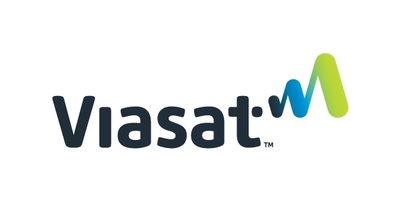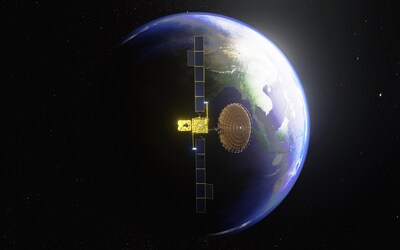The companies have successfully showcased direct-to-device smartphone connectivity
during this week's India Mobile Congress in New Delhi.
NEW DELHI
, Oct. 14, 2024 /PRNewswire/ -- Viasat, Inc. (NASDAQ: VSAT), a global leader in satellite communications, today announced it has successfully demonstrated direct-to-device satellite connectivity in India for the first time.
Working alongside partner BSNL, India's telecommunications provider, Viasat engineers successfully showcased satellite-powered two-way messaging services for attendees at India Mobile Congress — one of Asia's largest technology fairs. Viasat is currently working with its partners, including BSNL in India, to power the expansion of satellite services on consumer and IoT devices across the world.
In the trial, Viasat demonstrated two-way messaging and SoS messaging using a commercial Android smartphone enabled for non-terrestrial network (NTN) connectivity. The messages were sent roughly 36,000km to one of Viasat's geostationary L-band satellites. The outcome proves satellite services to cell phone connectivity is technically feasible for Indian consumers and businesses using Viasat's satellite network.
Direct-to-device connectivity is a new technology which allows everyday devices – like mobile phones, smart watches, or cars – industrial machinery, and transport operators to connect seamlessly to both terrestrial and satellite coverage. This means devices can stay connected from any location without the need for dedicated hardware to connect to satellites. The new technology follows new global mobile 3GPP release 17 standards, which are currently being adopted by satellite operators, mobile network operators, handset and chipset manufacturers.
Viasat has a longstanding heritage in providing satellite safety services – including providing the backbone of the Global Maritime Distress and Safety Service (GMDSS), with more than 120,000 connected safety terminals, and flight deck safety communications for over 12,000 aircraft. It provides these highly reliable safety communications through its licensed L-band spectrum.
Viasat is also a founding member of MSSA, a non-profit industry association formed to support open interoperable architectures and standards for integrating terrestrial and NTN services. For mobile network operators, using existing licensed satellite spectrum avoids tying up valuable cellular spectrum and avoids new regulatory approval processes.
Sandeep Moorthy, Chief Technical Officer, Viasat, said: "It is exciting to be showcasing the potential for direct-to-device in India, where D2D could help reduce barriers to accessing satellite connectivity – particularly in India where millions do not have access to reliable terrestrial connectivity. In the future, D2D could help transform the Indian production and supply chain to become more efficient, more sustainable and safer, and support automotive applications to enhance safety and conditions-based maintenance. Together with partners like BSNL, Viasat is driving a standards-based, open, transparent, collaborative D2D ecosystem to deliver seamless connectivity experiences no matter where a person, device, or vehicle is."
Robert J Ravi, Chairman and Managing Director, BSNL, said: "BSNL, in an exclusive partnership with Viasat, is proud to lead Direct-to-Device innovation. Today's successful demonstration, the first in India, showcases the potential to enhance direct communications for critical services, disaster recovery, and even rural connectivity across India using the BSNL network and Viasat's L-band satellite constellation."
About Viasat
Viasat is a global communications company that believes everyone and everything in the world can be connected. With offices in 24 countries around the world, our mission shapes how consumers, businesses, governments and militaries around the world communicate and connect. Viasat is developing the ultimate global communications network to power high-quality, reliable, secure, affordable, fast connections to positively impact people's lives anywhere they are—on the ground, in the air or at sea, while building a sustainable future in space. In May 2023, Viasat completed its acquisition of Inmarsat, combining the teams, technologies and resources of the two companies to create a new global communications partner. Learn more at www.viasat.com, the Viasat News Room or follow us on Facebook, Instagram, LinkedIn, X or YouTube.
Copyright © 2024 Viasat, Inc. All rights reserved. Viasat, the Viasat logo and the Viasat Signal are registered trademarks in the U.S. and in other countries of Viasat, Inc. All other product or company names mentioned are used for identification purposes only and may be trademarks of their respective owners.
Forward-Looking Statements
This press release contains forward-looking statements that are subject to the safe harbors created under the Securities Act of 1933 and the Securities Exchange Act of 1934. Forward-looking statements include, among others, statements that refer to the technical feasibility, potential benefits or future roll-out of direct-to-device connectivity in India. Readers are cautioned that actual results could differ materially from those expressed in any forward-looking statements. Factors that could cause actual results to differ include: future partnerships in India required to deliver direct-to-device services; network availability or satellite capacity required to scale direct-to-device services; our ability to realize the anticipated benefits of satellites and any future satellite we may construct or acquire; risks associated with the construction, launch and operation of satellites, including the effect of any anomaly, operational failure or degradation in satellite performance; the effect of adverse regulatory changes (including changes affecting spectrum availability or permitted uses) on our ability to sell or deploy our products and services; changes in the way others use spectrum; our inability to access additional spectrum, use spectrum for additional purposes, and/or operate satellites at additional orbital locations; competing uses of the same spectrum or orbital locations that we utilize or seek to utilize; In addition, please refer to the risk factors contained in our SEC filings available at www.sec.gov, including our most recent Annual Report on Form 10-K and Quarterly Reports on Form 10-Q. Readers are cautioned not to place undue reliance on any forward-looking statements, which speak only as of the date on which they are made. We undertake no obligation to update or revise any forward-looking statements for any reason.

 View original content to download multimedia:https://www.prnewswire.com/news-releases/direct-to-device-satellite-services-successfully-trialed-for-first-time-in-india-by-viasat-and-bsnl-302276215.html
View original content to download multimedia:https://www.prnewswire.com/news-releases/direct-to-device-satellite-services-successfully-trialed-for-first-time-in-india-by-viasat-and-bsnl-302276215.html
SOURCE Viasat, Inc.
![]() View original content to download multimedia:https://www.prnewswire.com/news-releases/direct-to-device-satellite-services-successfully-trialed-for-first-time-in-india-by-viasat-and-bsnl-302276215.html
View original content to download multimedia:https://www.prnewswire.com/news-releases/direct-to-device-satellite-services-successfully-trialed-for-first-time-in-india-by-viasat-and-bsnl-302276215.html

